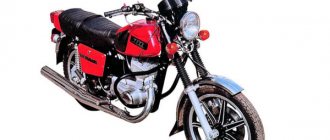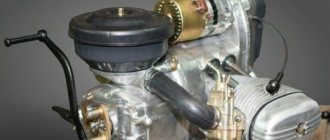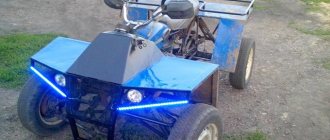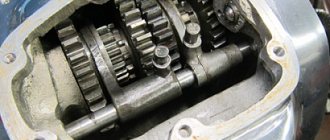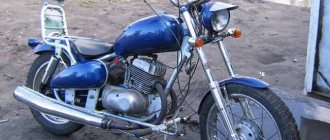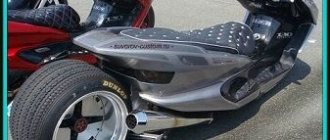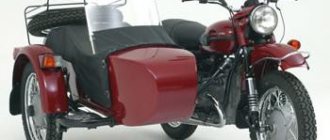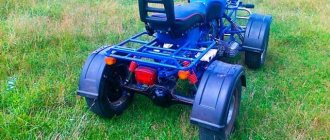Preparing the Ural motorcycle for off-road use (Part 1)
In this article, we have already discussed the advantages and disadvantages of the Ural motorcycle in terms of off-road travel. But the stock Ural without a stroller is not very easy to use; there is nowhere to even put tools and spare parts, not to mention a shovel, fishing rods and a metal detector. I consider the stroller to be useless ballast. Yes, it allows you to carry more cargo and one more passenger, makes the motorcycle safer and more stable, and even then not in all situations. This is where the advantages of using a side trailer end, and it has more than enough disadvantages:
- serious deterioration in dynamics;
- deterioration of passability;
- increased fuel consumption (1.5-2 times);
- shorter lifespan and high risk of overheating, especially in mud.
There are probably other disadvantages, but now we’re not talking about them, but about preparing the Urals without a stroller for off-road driving and active recreation.
Why exactly “Ural”?
Indeed, why did the choice fall on this particular technique, since the Ural motorcycle is not the best for off-road use? There are many other options: IZH and other Soviet motorcycles, as well as Chinese and Japanese enduros. The Urals were chosen because:
- was available;
- easy to repair and maintain;
- it is easy to find spare parts that are relatively inexpensive;
- cardan transmission (I consider this a very big advantage of the Urals);
- high structural strength, reliability and overall survivability;
- I have decent experience in operating, maintaining and repairing this motorcycle.
In general, instead of a motorcycle for trips to the mines and fishing, you could use an ATV or an SUV, but the Ural was already available and for my purposes it was perfect.
Ural motorcycle prepared for off-road
Off-road tuning of the Ural motorcycle: general points
In general, my modification or, as they say now, tuning the Ural motorcycle with my own hands, pursued the following goals:
- increasing the cross-country ability and reliability of the motorcycle;
- increasing the convenience and comfort of movement;
- reducing the visibility of the motorcycle;
- the ability to transport tools, spare parts and other luggage;
- maybe something else.
The result was a kind of do-it-yourself enduro from the Urals, which took about three full days to create. In general, the design of the motorcycle has not undergone any major changes; it wasn't necessary.
Khaki color suits this bike perfectly
Sport
This is a rather unusual and not common type of tuning of a Ural motorcycle, but it still takes place. For sharp control of such a motorcycle, you need a sports fork and powerful disc brakes. Sports tires provide minimal friction with the road surface and are slightly wider for confident grip in corners and at high speed. The streamlined gas tank will have to be picked up from another sports motorcycle, and the rear part will have to be “lifted” higher to give the motorcycle an aggressive appearance. You can make mufflers in the form of cans yourself from thin-walled stainless steel, then fill the walls of the mufflers with mineral or basalt wool, which perfectly absorbs high frequencies, the exhaust will remain direct-flow, and the exhaust will become “juicy”. If desired, you can convert the pendulum to one mono shock absorber, which is a definite plus in terms of appearance.
Conclusion
In the next article (or articles) I will tell you in detail about how this Ural enduro motorcycle was created. Overall, I was completely satisfied with the result; Over the course of several visits, no serious deficiencies were identified. Of course, this is not the final version yet; plans include installing “toothy” tires, final painting, installing new rims and maybe something else, as well as changing the oil, piston rings and other repairs. First of all, it is worth installing toothy tires, because... On a regular road motorcycle, the Ural rides very, very poorly in the mud, almost not at all.
Installing motocross tires is a top priority
Source
Tuning a Ural motorcycle that won’t interfere with the classics - why a motorcycle?
Time does not stand still, technology is constantly evolving, new, more modern opportunities for people appear. But, there is a technique that is not subject to temporary changes: the Ural motorcycle. The pride of the Irbit plant is known to all domestic motorcyclists, and Ural tuning is the real pride of Russia.
Tuned Ural motorcycle
Over the past few years, production has become more modernized, most of the work is done by machines, and Ural tuning has improved significantly. Today, the plant is receiving foreign investment and, together with international specialists, domestic craftsmen are working to improve the model range. Motorcycle tuning and modernization comes to the fore in the company. The successful start of the new generation Ural model M70 Sidecar is evidenced by the tuning of this Ural motorcycle made in accordance with all international requirements.
Tuned Ural motorcycle
According to a sociological survey, the most popular motorcycle of the new millennium is the Ural motorcycle. Tuning it can characterize the owner and depends directly on his preferences. At the factory, most models are equipped with a stroller, which is designed to transport passengers. Tuning a Ural with your own hands can be done regardless of whether the vehicle is equipped with a stroller or not. If it is, you can tune the Ural stroller. There are many useful recommendations on this matter on the Internet; just enter in one of the search engines: “Ural tuning video or Ural motorcycle tuning video.”
The opinion of plant director N. Volozhanin on this matter:
“The design of the motorcycle has remained unchanged for a long time because we have not received any comments from athletes, clubs, or the Central Committee of DOSAAF of the USSR. This is all the more surprising since it is the specialists from the Defense Society who must determine the technical policy and, on its basis, help the plant improve each model. It is impossible to discontinue the currently produced motorcycle, since it is intended for beginner athletes. With the construction of a new workshop, we will be able to master the production of a new model in the shortest possible time - one year.”
Agree, the arguments of the company’s managers are not very convincing, although, we understand, they have many problems, both technical and economic, that need to be solved. And yet it is hardly possible to explain the hopeless backwardness of the design by the lack of signals from consumers. Firstly, this is not true, and secondly, the management employees of the Irbit plant have themselves been to international competitions more than once and have a great idea of what a cross-country motorcycle with a sidecar should be like.
The long-awaited new workshop is unlikely to solve the problem if components and parts from serial production are still used on sports motorcycles. The prospect of a sharp increase in the price of motocross cars to several thousand rubles is very alarming. If we are talking about unique cars produced in limited numbers for international competitions, that’s one thing. Other - for sports clubs and sections. They need a reliable modern motorcycle, supplied assembled and in parts, at a real, affordable, and not a fantastic price.
And in conclusion, I would like to return to where we started - the unsuitability for sports of all domestic sports motorcycles. What we saw, having examined in more detail the design and production of the Irbit cross-country motorcycle, is to a greater or lesser extent inherent in sports cars of the Izhevsk, Kovrov and Minsk motorcycle plants. In this regard, it is time for VNIImotoprom, the Department of Automotive Service, Trade and Services to the Population of the Ministry of Automotive Industry, specialists from other ministries and departments, together with the USSR Motorsports Federation, the Directorate of Technical and Military Applied Sports of the Central Committee of DOSAAF of the USSR, to seriously address the problem, to take control of the implementation of those government regulations regulations by which the motorcycle industry pledged to provide motorsports with modern technology. Because what is happening now - the production of motorcycles unsuitable for sports cannot continue. This is a waste of funds, materials, and labor resources. V. SUBBOTIN, engineer
External tuning
The original design of the Ural is already impressive, especially if you like the classics. But there is no limit to perfection. Owners of this motorcycle tend to customize the motorcycle according to their personal tastes. Of course, all work to improve the motorcycle can be ordered at the salon, but a real biker will always prefer to do the tuning of the Ural motorcycle with his own hands. The tuning process may be lengthy and require effort, but the result will certainly be worth it.
The following changes are most often made in the appearance of the “Ural” iron horse:
- Handles, mirrors and fairings are changed.
- The seat is made single.
- Get rid of massive “wings”.
- The steering wheel is raised and straightened slightly.
- The footrests are moved forward to make riding more comfortable.
- The original fuel tank is replaced with a streamlined tank. Tanks from motorcycles “IZH-49”, “Planet”, “Jupiter” and “IZH-56” are suitable for the “Ural”. If you have an old Ural model, then you can install a Java-250 tank on it.
- If the owner wants to turn his Ural into a chopper, then the rear wheel should be replaced with a wider one. The optimal size is 130-150. The wider rear wheel requires replacement of the rear frame.
- Parts are chrome plated.
- The clutch and brake levers are replaced with ones cut from a piece of solid metal.
- The muffler is located on the right side.
Of course, each motorcycle owner decides for himself how far he will go to change the appearance of his “iron horse”. The cost of this model is quite high, so if you need a completely modified bike, it is better to buy something more affordable. But if you like the classic Ural motorcycle, this is your choice. Photos of tuning these bikes can be found on the Internet and you can choose the option that you will focus on.
Inner harmony
Many owners start tuning the Urals to improve the technical characteristics of the motorcycle. Despite some orthodoxy in the design of the engine and gearbox, there is room for improvement here. The following steps can be taken:
- Installation of crankshaft (crank) support bearings, the quality of which is better than standard ones. It is not recommended to reduce the size of the support necks themselves. After all, this removes the heat-treated layer and reduces the strength of the critical elements.
- Reduced weight of pistons and connecting rods. Excess mass of these parts leads to an increase in the moment of inertia and a decrease in engine power. Even simply by removing the casting flash, you can significantly reduce the weight and increase the effective output of the power unit.
- Alignment and grinding of inlet and outlet channels. Grinding in valves. Such procedures will improve the filling of the cylinders with the combustible mixture.
- Manufacturing a new camshaft with a different cam profile, allowing the valve timing to be changed. This is a complex engine tuning that requires special knowledge.
- Installation of new carburetors. A well-proven measure that allows you to get rid of failure during acceleration, which is characteristic of all IMZ models without exception. This is due to the fact that the manufacturer equips the equipment with variable-discharge carburetors, which are poorly suited for four-stroke motorcycle engines.
You can get rid of this by equipping the motorcycle with suitable constant-vacuum carburetors. Both Mikuni and Keihin have such models. To optimize operation, the flow area of the nozzles will need to be adjusted. Ideally, such modifications are carried out on a special stand. In the absence of one, one has to be content with fitting in road conditions. After such engine modernization, the Ural will accelerate much more confidently.
- Replacing standard air filters with others that have similar throughput but less resistance.
- Installation of inertial boost. This will only work if you purchase components from a reputable manufacturer. There are often low-quality or even non-functional components on the market.
- Manufacturing of new gearbox gears. Despite the relative labor intensity, this motorcycle tuning is more than justified. Original gears are often not of high quality and not only make it difficult to change gears, but also make noise during operation.
- Installation of alloy wheels. Such modernization is not always justified. A cast wheel, if it is not spoked, will look ridiculous on a classic.
Disadvantages of IMZ-8.201 Cross
With regret about IMZ 8.201 Cross and not only about it. Talk to motorcyclists who compete on our cross bikes and other sports motorcycles. You won't hear two opinions. The cars of the Izhevsk, Kovrov, Irbit and Minsk factories, both in design and execution, are completely unsuitable for sports. A radical alteration is required, large expenditures of labor, money, and materials are required in order to somehow adapt them to the conditions of the competition, and even then for a short period of time.
For many years, the sports community has been sounding the alarm about this. But, probably, it’s time to figure it all out, give a detailed assessment of the products that young athletes receive, and answer the question of whether this can continue. Let's try to do this using the example of an Irbit cross-country machine, designed for our very favorite competitions on motorcycles with sidecars.
So, IMZ-8.201 “Cross”. While preparing this publication, we talked with many athletes, mechanics, and coaches and noted the coincidence of critical remarks addressed to the motorcycle plant and its motorcycle. We will try to group them by components and assemblies and at the same time give an idea of the amount of work that the athletes themselves have to do to get the motorcycle to the start of the competition.
Power unit. The reliability and durability of its components is extremely low. On an unmodified motorcycle, the likelihood of any part breaking - gears of the gearbox, main gear and others in one ride is almost inevitable. The flywheel is unbalanced, and at high speeds this leads to enormous vibration, which, in turn, destroys, for example, the oil catcher - a device that supplies oil to the connecting rod bearings of the crankshaft. The holes for attaching the oil trap are made extremely poorly on the crankshaft cheek; they greatly reduce the strength of the cranks, which leads to the formation of cracks in this place. As a result, the crankshaft fails. Knowing this, the athletes disassemble the new engine and install oil catchers of their own design made of duralumin, having previously plugged the holes for the factory catcher.
The front cover of the crankshaft main bearing, which fixes its displacement, is made of low-quality metal. When the engine is running, the material under the bearing subsides and the crankshaft journal begins to “describe circles.” Naturally, the heads of the bolts securing the cover fly off. They get into the gears of the gas distribution mechanism. Consequences: destruction of gears or engine crankcase. The same can be said about the rear bearing housing, adding that here, at the initial stage, oil leakage to the clutch discs is possible. Athletes are forced to make their own front cover from 30KhGSA or 40X steel with an increased fit into the crankcase (up to 0.04 mm). The back cover is made of D6T duralumin with developed stiffeners.
Due to inaccurate manufacturing of the connecting rod lower end bearing cages, this unit can withstand an average of only five races. On the cylinder head, where the exhaust pipe is inserted, also after a short time (especially with sudden temperature changes), the tide under the exhaust duct bursts.
The valve springs of the gas distribution mechanism not only do not meet the required characteristics, but are also often incorrectly selected along the valve path. When compressed, the coils of the spring rest against one another.
But the most painful place of the power unit is the gearbox. It is unsuitable for motocross not only in terms of gear ratios, but also in its ability to withstand high loads. According to the evidence of cross racers, the factory gearbox can withstand a relatively short section of the distance, but not an entire race. Motocross riders find a way out of this situation. But what! Instead of a standard gearbox, they make their own (can you imagine it) with reinforced gears and shafts (gear ratios - 16:10; 34:12; 32:14; 30:16).
The rubber coupling, through which the torque from the secondary shaft of the gearbox is transmitted to the cardan, like many parts of a sports motorcycle, is borrowed from the serial IMZ-8.103. It is completely unsuitable for transmitting the forces of a sports engine. This applies to the driveshaft, to the crosspiece - a part of the universal joint, to the final drive gear. So the athletes install a coupling from an SZD motorized stroller, a crosspiece of their own making, increase the diameter of the cardan shaft (up to 19 mm), and replace the conical pair with a more powerful one.
Improving any unit entails changing other parts associated with it. The reaction moment of the rear axle housing is too large for the four studs on which it is attached to the pendulum fork. It is advisable to install jet traction and unload the studs, which is what is done on sports motorcycles. But this, in turn, requires strengthening the pendulum, since its torsional resistance is low, and the load during the race is large.
Chassis. On a factory frame, a motorcycle, as motocross masters say, does not “stand” on the track. And so the new frame is cut and redesigned from the very beginning: the rear part is completely changed, the tilt of the steering column is increased to 30°. The telescopic front fork simply cannot work on a sports track. When turning, it twists, it is impossible to really provide the rigidity it needs - as a result, the motorcycle becomes uncontrollable.
The telescopic fork in cross-country racing was abandoned a long time ago. Athletes switched to a lever-type fork. Stability, controllability, and reliability of its operation have become an order of magnitude higher. The steering damper is a must-have element when driving over rough terrain. The friction damper installed on the IMZ-8.201 motorcycle, no matter how you tighten it, is not able to dampen the torsional vibrations of the fork that occur when an obstacle impacts the wheel from the side. That’s why athletes in motorcycle clubs install hydraulic dampers. The performance of the rear shock absorbers is also poor. In addition, they are attached to the frame and pendulum via silent blocks. Large bending moments that occur during compression of shock absorbers cause the rods to bend, oil leaks, and the damping element becomes inoperative. Motorcycle clubs use homemade shock absorbers with a suspension travel of 135-140 mm.
Based even on the cursory analysis of the IMZ-8.201 design given here, it can be argued that the motorcycle is not only not suitable for cross-country racing, but is also unsafe for the athletes themselves. With all this data, we went to the Irbit motorcycle plant and introduced the company’s managers to it. Here is the answer from chief designer I. Koshelev:
“To produce modern sports motorcycles, you need to have a small series workshop. Now the experimental production of the chief designer is not able to cope with such a task. The number of machines can be counted on one hand; by the way, the youngest of them is manufactured in 1979, and they also work for the main production. The production volume of sports motorcycles needs to be reduced by three times - make 50-70 units per year and, of course, reconsider the price. Now the production of the motocross motorcycle IMZ-8.201, the price of which is 744 rubles, is economically and morally unprofitable for the plant. We are ready to develop technical documentation for the new machine and within six months begin its serial production, subject to the above conditions. True, its price will reach 6,000 rubles. Who will buy it?
Additional engine modifications
In addition to the above methods of tuning a Ural motorcycle, there are several more secrets. It is possible to install a crankshaft from the K 750 on the Ural engine, which will increase the cylinder stroke to 78mm.
Thus, it is possible to significantly increase the working volume of the Ural engine. It's quite difficult to find, but it's worth it. Another problem with the motorcycle is the tight response to the throttle and slow acceleration. The reason for this is that the flywheel is too heavy, the weight of which is designed for riding with a stroller and for transporting heavy objects.
According to the drawing, it is possible to reduce its weight by a couple of kilograms. Due to the weight reduction, the inertia of the crankshaft will decrease, and the acceleration dynamics will significantly increase. To fully realize the power on the road, the gears of the gearbox must be replaced with 9 or 10 pairs. In conclusion, we would like to note that tuning the Ural motorcycle engine is justified only for racing purposes; for everyday use, such an engine will have a short resource and significant fuel consumption.
Cross-1000 is a Soviet heavy cross-country motorcycle with a sidecar. Produced by the Irbit Motorcycle Plant (IMZ Ural) in small batches for riders competing in USSR championships and international competitions.
IMZ-8.201 “Cross” sports motocross motorcycles by order of the USSR DOSAAF Central Committee
These motorcycles are produced on the basis of serial models and were suitable for competitions at the championship level of a region, zone or republic.
The engine has increased power due to the use of a piston with a spherical bottom and an increase in the compression ratio to 8.5, which requires the use of high-octane gasoline AI-93. The lubrication system is designed without a full-flow oil filter. Ignition is carried out from a magneto, which made it possible to abandon batteries, reduce the weight of the motorcycle and obtain a stable spark supply.
Many years of operating experience have shown that the engine of a motocross motorcycle provides fairly high parameters with optimal reliability. Motorcycle IMZ-8.201
has a special cross-country wheelchair, which provides optimal conditions for the wheelchair user to work during competitions. The travel of the front fork, rear suspension and sidecar wheel does not differ from those of a production road motorcycle.
Such equipment has been in demand for many years not only in the civilian market, but also in the army. Cadets and young military personnel were trained to ride motorcycles in difficult conditions at high speeds, throw grenades and shoot on the move.
Back in the early 1970s, a special model “Ural-Cross-1” began to be produced in small batches in Irbit, which met all the then requirements of the International Motorcycle Federation for world-class motocross. In the cross-country modifications, the motorcycle received a frame that was shortened compared to the “civilian” versions, a more durable suspension, an engine boosted to 55 horsepower, a magneto ignition system that is not afraid of contact with water, and a lightweight stroller, convenient for riding over rough terrain while standing.
Motorcycles from the Ural-Cross
The first generations had engines of 750 and 1000 cubic centimeters, and then DOSAAF branches across the country began to receive racing models with 649 cc engines designed for AI-92 gasoline.
IMZ 8.201, presented at the Irbit Motorcycle Museum, belongs to the latest series of domestic cross-country motorcycles with sidecars. Its production began during the perestroika years and ceased in the early 1990s, when the flow of orders for sports equipment finally dried up, and in many regions they stopped holding cross-country competitions on sidecar motorcycles.
Specifications:
Show/Hide text
Overall dimensions, mm, no more than: length - 2550 width - 1670 height - 1140 Ground clearance, mm, no less than -240 Weight (dry), kg, no more than - 230 Engine type - four-stroke, overhead valve, opposed Displacement, l - 0.950 Cylinder diameter and piston stroke, mm - 88Х78 Compression ratio 9.5 Maximum power, kW - 48 Crankshaft speed at maximum power, min - 6000-6200 Ignition - battery, 12 V Carburetors - "Dell'Orto", diffuser diameter 34 mm Air filter - with polyurethane foam element Fuel - AI-93 gasoline Oil - MS-20 Brakes: front - disc with hydraulic drive, rear - drum with mechanical drive Front fork - lever (travel 180 mm) Rear suspension - pendulum (travel 210 mm) Wheels ( not interchangeable): Front - 3.75 X 19" Rear - 4.75 X 18" strollers - 3.5 X 16" Stroller - special, tubular, made of 30HGS steel
History of the Urals
The world first learned about this new product back in the 20s of the last century, and then the first copy was produced with a powerful 1,200 cc engine and a power of only 24 hp. At low speeds the Ural handled perfectly, but after the 60 km/h mark this indicator disappeared. It is also worth noting that the designs and some parts of the motorcycle were borrowed from another foreign manufacturer, so the first Ural M-72 was not completely Russian, it had a particle of the German BMW R-71.
Then the manufacturer experienced several ups and downs; World War II forced them to reconsider production. After the war, the bikes were produced as military motorcycles with a special design: PKMB machine guns were built into them. Further in the Soviet Union, the legend was actively sold; about 3 million copies were sold.
Today's Urals are represented by several models. They are equipped with an engine with a volume of 750 cubic meters and a power of 40 horses. With a large weight of 200 kg, the motorcycle is capable of traveling at high speed without losing control. Also, the new motorcycles received a completely standard, but stylish appearance, which is made in a militaristic style.
Irbit "strollers"
On November 17, 1941, the first echelon of the Moscow Motorcycle Plant arrived in Irbit - from that day on, the city was doomed to motorsports. The war was still going on when the first motocross was held in Irbit.
For more than 60 years, one of the best motorsports schools in the country in the “motorcycles with sidecars” category has been operating in Irbit. Since 1945, 59 Irbit racers have become champions of the USSR and Russia - they have more than 226 gold medals to their credit! Some won this high title once, and some more than a dozen times.
On June 25, 1944, demonstration performances took place, about a dozen riders took to the start in “single” M-72s, two in foreign cars - BMW R-71 and Royal Enfield J. But the first official motocross was held by Irbitsk residents on June 17, 1945. Why official? Because the city committee of the All-Union Communist Party of Bolsheviks joined the organization, and now this date is considered the birthday of motorsports in Irbit. About two dozen participants started on singles and only one “sidecar” M-72. To everyone's delight, the duo of young motorcycle testers - Veniamin Gubin and Alexey Dubskikh - showed an excellent result, slightly losing to the winner. Why did you perform on a motorcycle with a sidecar? Legend has it that Gubin was short in stature and could barely reach the ground with his feet on the single M-72. The guys also carried out the first modification of the side trailer. There were many ditches on the track, and so that the back of the stroller would not cling to the ground, the crew without regret parted with the luggage compartment, shortening the “boat”.
For the 1945 USSR Championship, Irbitsk residents entered five crews in the wheelchair class. The competition took place in the vicinity of Moscow at the 23rd kilometer of the Minsk Highway. The IMZ team from the first “batch” became the winner in the 300-kilometer linear race, where the Igor Okunev/Alexei Antropov crew achieved particular success. The Irbit duo set an All-Union record for covering 300 km on a specially prepared M-75. Okunev and Antropov covered this path in 2 hours 56 meters 9.9 seconds, improving the previous record by more than 30 minutes. In the cross-country, 2nd place was taken by the already well-known pair - Veniamin Gubin / Alexey Dubskikh on the M-72. Looking ahead, let's say that they will also become champions and prize-winners of the USSR and the RSFSR.
In preparation for the 1947 national championship in two disciplines - “ring” and “cross”, special sports strollers were produced at the Irbit Motorcycle Plant (for the first time in the country on an industrial basis). They called them “TT”, by analogy with the famous race on the Isle of Man - “Tourist Trophy”. The stroller was universal - both for road racing and cross-country. On the eve of the championship of the Soviet Union, the championship of the RSFSR was held in Serpukhov. Six Irbit crews took off using updated equipment. For the road race, an M-75 engine was installed in a lightweight chassis, and for cross-country racing, an M-72 engine was installed. Using such equipment, the Irbitsk team was beyond competition, and the pair Alexander Lukoyanov/Nikolai Sachkov became the absolute winners of the RSFSR - both in road racing and cross-country. This crew also performed brilliantly at the USSR Championships in Tallinn - victory on the “ring” and second place in the cross-country. Of course, the “TT” stroller was not perfect and had a rigid wheel suspension (racers called it a “double-support”). Torsion bar suspension appeared only in the early 50s.
Cross-country tracks of that time were significantly different from modern ones - they were laid along country roads, through swamps and fords, through ravines... The circle of such a track was 25-50 kilometers, the entire distance was 50-100 kilometers (several laps). Riders often had to pull the motorcycles out by hand. This is where various devices on motorcycles came from, including handles on the front and rear guards. The stroller had a special seat for the convenience of the wheelchair user while kneeling. On flat sections of the highway, the “passenger” could rest on this pillow.
In Irbit, winter is long - snow lies from November to April. So winter racing is in order for Irbitsk residents. Often the tracks were laid along a “crossroads” with partial use of horse roads, on which, due to the limited width, only a motorcycle could fit, and the side trailer moved across the virgin soil. Therefore, instead of a wheel, a special metal ski was installed on the stroller.
All kinds of new products were developed for sports in the department of the chief designer of the plant. Since 1952, they began to produce cross-country M-72Ks in small batches for the country's leading clubs. Considering that fording was an invariable component of motocrosses of that time, the air intake was placed in the upper part of the gas tank. Production of the M-72K lasted six years, and just over 300 motorcycles were produced. Having received such a device, the racers themselves “brought it to mind” - they installed a friction shock absorber on the spark plug suspension of the rear wheel, installed a hydraulic damper, etc.
From 1959 to 1965, the M-61K was mass-produced in Irbit. An overhead valve 650 cc 28-30 hp M-61 engine was installed in the M-72 chassis with the spark plug suspension stroke increased by 20 mm. 855 of these machines rolled off the plant’s assembly line, not counting those motorcycles that were made specifically for Irbitan racers. At the end of the 50s, the M-52K was also produced on the basis of the serial M-52 (working volume 494 cm³).
By the early 60s, Irbit had become one of the country's recognized leaders in motorsports in the wheelchair class. Therefore, it is no coincidence that in 1962 he was entrusted with holding the Union motocross championship. In those years, the tracks underwent radical changes - they were no longer hundred-kilometer “mud” roads, but spectator-friendly loop tracks (2-4 km in length) with a set of natural obstacles. For the factory team at IMZ they developed and manufactured a new motorcycle, the Cross-650. A high-speed 40-horsepower engine spinning up to 6,000 rpm, a rear swingarm and a weight reduced by 15 kg made the car modern and fast. The seat was also removed from the stroller - there was no time for the wheelchair user to rest on the new route.
38 crews came to Irbit for the national championship, 9 of them were already champions of the USSR at different times (the crew title is always based on the driver). Among them are Evgeny Kosmatov (Moscow), Alexander Razorenov and Yuri Sokolov (both from the Investigative Committee of the USSR Armed Forces), Vladimir Volchkevich (Leningrad), Irbitsk residents Genrikh Vartanyan, Veniamin Gubin, Anatoly Bykov and others. The result amazed everyone. In the free class “from 350 cm³ and above” the entire podium was occupied by representatives of one team - the Irbit Motor Plant. The title of USSR champions was won by the crew of Henrikh Vartanyan/Victor Karzhavin, the duo Leonid Leshkov/Evgeniy Korolev took the silver, and the bronze medal went to the pair Veniamin Gubin/Gennady Borodin. Yes, this is the same Veniamin Gubin from the distant “forty-fifth”!
The next new product in 1969 was the M-64K, already with a 750 cc engine, a lever front fork and an enlarged steering column bearing. However, this motorcycle did not receive recognition. The reason was the gathering of all four crews of the factory team at the national championship in Vilnius. There is only one reason - the steering column bearing is jammed.
Until the early 70s, Soviet “strollers” did not travel abroad. In 1971, they were finally released to three stages of the FIM Cup, the forerunner of the European Championship. The team consisted of three crews: Irbit couples Anatoly Sibirtsev/Igor Nikonov and Valentin Telegin/Petr Sosnovskikh, Moscow duo Valery Alfeev/Alexander Kuzovkin. Our racers competed on 45-horsepower IMZ Cross-750 cars. And although they consistently ranked in the top ten, they had to fight not on equal terms - the rivals’ motorcycles were 30-40 kilograms lighter and much more powerful than ours (60-70 hp).
The foreigners were especially amazed by the strollers. It was much more convenient to work in them; they weighed 15-20 kilograms lighter than ours. Pyotr Sosnovskikh and Igor Nikonov (craftsmen from God), with the permission of their foreign colleagues, carefully studied European technology, making the appropriate measurements. The next year, Europe, previously amazed by the “tank-like” appearance of Russian cars, saw “civilized” motorcycles. At the very first stage in Belgium, the crew of Anatoly Sibirtsev/Igor Nikonov became winners, and Valentin Telegin and Pyotr Sosnovskikh took third place!
Since then, these strollers in Irbit began to be called “Swedish”. The advantage of the “Swedish” stroller, compared to the old one, is undeniable. The author himself had to work on both options. It has become much more convenient and safer to help the driver control the motorcycle, both during a jump and on turns, especially on the right. In the old version, you had to load the back of the stroller and try to help the driver move the front wheel in the right direction. Physically it was not so easy. In the “Swedish” stroller, the front part of the stroller is loaded and the rear wheel of the motorcycle is partially lightened (there is a slight slip), due to the centrifugal force it is much easier to take a right turn. And the loop at the bottom of the arch mount when passing the left one helped the wheelchair user to cling with his foot.
Since 1977, they decided to hold the USSR Championship in two classes: “free up to 1000 cm³” and “national up to 650 cm³”. If the “1000” had no design restrictions, except for the ban on the use of components and parts produced in capitalist countries, then with the new “650” they did the incredible. Everyone was required to perform on mass-produced “cars” without any modifications, i.e. on M-63K. It was a step back. After all, by this time the leading racers of the country were already racing on motorcycles with a pendulum fork, a “Swedish” sidecar, reinforced reverse gear, with a close gearbox, with Czech carburetors... Why did they do this? This was determined by DOSAAF: let everyone compete in production cars under equal conditions. The results of the 1977 national championship in this class looked depressing. All the strongest racers retired for technical reasons, and the classification was given to crews with a soft, “walking” style of racing, without much overload of the engine and chassis, without much risk on the track, which is so necessary for victory.
The following year, there were relaxations in the 650 class. They allowed a “Swedish” sidecar, a pendulum fork, and a reinforced reverse gear, but they didn’t allow a closer gearbox. Some racers secretly circumvented such prohibitions. The lack of a serial gearbox was skillfully compensated for by replacing the standard “eight” rear gear (based on the number of teeth on the shank) with a “seven”. In the “1000” category, some craftsmen also circumvented the ban on using components from capital countries. For example, perfectly working Bilstein gas-filled shock absorbers were skillfully disguised as homemade products.
In the second half of the 80s, realizing that we were far behind Europe, sports officials lifted all restrictions. The 650 class was instantly transformed. The serial frame was replaced with a special, lightweight one (the author was one of the developers of such a frame and successfully defended his thesis on this topic at the Irbit Motorcycle College back in the early 80s). “Large travel” appeared for both the rear wheel and the stroller. And later - mono-suspension of the rear wheel with “progression”, disc brakes on both wheels, etc. The experimental workshop of the plant produced 10-20 such devices per year until the mid-90s. The dominance of the Irbitsk team in the “union” in the “650” class, starting in 1987, was undeniable in these cars, and only occasionally did representatives of other teams get on the podium.
In the 70s and until the mid-80s, the plant produced special cross-country vehicles with 750 and 1000 cm³ engines for the country's leading racers. They were produced in limited quantities at the request of TsAMK in the experimental workshop. Our athletes rode these motorcycles not only at domestic championships, but also at European and world championships. However, at the same time, the plant’s conveyor belt continued to churn out the wretched IMZ-8.201 - a pile of obsolete scrap metal. In DOSAAF, when they received such cars, they were openly perplexed: “Why does the plant, having excellent modern cross-country motorcycles, supply them with such squalor?” Meanwhile, the plant repeatedly tried to launch the production of more modern devices on which one could perform without fear for one’s health.
But all these notorious ministerial and departmental approvals, permits, clarifications, limits, etc. plunged the developers' initiative into a bureaucratic abyss. At this time, from 500 to 1000 obsolete cars rolled off the assembly line annually. The last five IMZ-8.201 were assembled in 1992. With the collapse of the Soviet Union, I left the cross-country bike, which at that time was more suitable for extreme hunting or fishing trips than for participating in a race, even at the yard level.
Alexander Bulanov is the director of the Irbit State Motorcycle Museum, master of sports in motocross, champion of Russia (1982), record holder of the Guinness Book of Records. In 1992, Alexander Bulanov and Anatoly Bekishev drove a Ural with a raised stroller 1014 km in 24 hours along the stadium treadmill. In 1993, Alexander Bulanov, Anatoly Bekishev, Konstantin Matveev drove 25,505 km non-stop in 440 hours in the Ural.
Alexander Bulanov, photo from the author’s archive Moto magazine 2010/12
Complex modifications
It is not difficult to guess that this category does not include external changes. But the internal ones are quite enough. Carrying out tuning with their own hands, some owners make adjustments to the design of the motorcycle that are prohibited by law.
